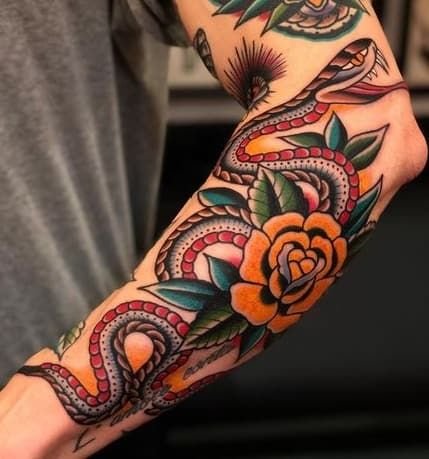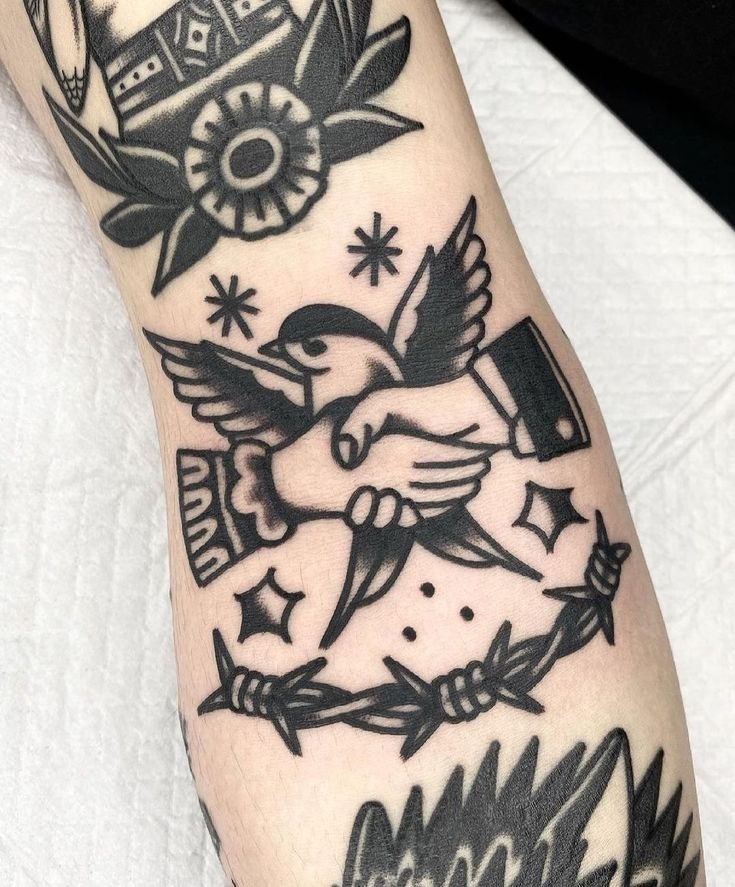What are Traditional Tattoos?
Updated: September 21, 2025
Traditional tattoos hold a rich history that spans centuries, rooted in cultural significance and personal expression. These timeless designs have captivated people worldwide, enduring the test of time and evolving into a prominent form of body art.
In this article, we delve into the history of traditional tattoos, their enduring popularity, and highlight some renowned traditional tattoo artists.
Source: PinterestThe History of Traditional Tattoos
Traditional tattoos have a fascinating heritage deeply embedded in various cultures. Dating back thousands of years, these tattoos served as symbols of tribal affiliation, rites of passage, status, and personal narratives. Indigenous communities across the globe, from Polynesia to Native America, practiced traditional tattooing long before it gained widespread recognition.
Polynesian tattoos, known as Tatau, were among the earliest forms of traditional tattoos. These intricate designs were deeply ingrained in the Polynesian culture, symbolizing social status, achievements, and spiritual beliefs. Similarly, Native American tribes adorned their bodies with symbolic tattoos, representing their tribal affiliations, warrior status, and spiritual connections.
Popularity and Resurgence
Traditional tattoos experienced a resurgence in the late 19th and early 20th centuries, primarily through the works of tattoo pioneers such as Sailor Jerry, Don Ed Hardy, and Amund Dietzel. These artists popularized traditional American tattoos, characterized by bold, iconic images, vibrant colors, and strong outlines.
During this period, traditional tattoos became synonymous with sailors, soldiers, and individuals seeking to make a bold statement. These designs included anchors, pin-up girls, eagles, roses, and other iconic imagery. Traditional tattoos became a way to commemorate experiences, show loyalty, and display individuality.
In recent years, traditional tattoos have witnessed a resurgence in popularity, thanks to a renewed interest in the timeless aesthetics and nostalgic appeal they offer. People seeking bold and classic designs are drawn to the simplicity and boldness of traditional tattoos. The enduring charm of these designs continues to captivate tattoo enthusiasts and artists alike.
Popular Traditional Tattoo Artists
Many tattoo artists today carry on with this popular tattoo style. Some popular traditional artists today include:
Chad Koeplinger - Chad Koeplinger draws inspiration from various sources, including vintage tattoo flash, Americana, folk art, and punk rock aesthetics. His designs often feature bold symbols, such as eagles, panthers, skulls, and pin-up girls, executed with a raw and energetic approach. Koeplinger's tattoos have a timeless quality and exude a sense of nostalgia while maintaining a contemporary edge.
Bert Krak - Bert Krak is a highly respected tattoo artist known for his exceptional skill in traditional American tattooing. He hails from Brooklyn, New York, and has been tattooing for over two decades. With a passion for the classic tattoo style, Krak has become renowned for his bold and clean designs, executed with precision and attention to detail.
Bob Roberts - Bob Roberts was a highly esteemed tattoo artist who has made significant contributions to the world of tattooing. Born in 1948 in California, United States, Roberts began his tattooing career in the 1970s. He played a pivotal role in the resurgence of traditional American tattooing and is considered one of the pioneers of the craft.
The Role of Tattoo Conventions and Media
Tattoo conventions and media have played a significant role in the resurgence and adaptation of traditional tattoos. These platforms allow artists to showcase their work, exchange ideas, and educate the public about the history and significance of traditional tattooing. This exposure helps preserve traditional techniques while encouraging innovation within the art form.
The legacy of traditional tattoos is evident in their continued popularity and influence. As modern tattooing evolves, the timeless appeal of traditional designs ensures that they remain a cornerstone of the industry, celebrated for their bold aesthetics and rich cultural heritage.
Types of Traditional Tattoos Around the World
When people in the U.S. search for “traditional tattoos,” they may be thinking about classic American designs, but the term covers multiple cultural styles. Each version of “traditional” has its own history, look, and symbolism.
American Traditional (Old School)
This is what most Americans picture when they hear “traditional tattoo.” Popularized in the mid-1900s by artists like Sailor Jerry, American Traditional tattoos are known for:
Bold black outlines
A limited color palette (red, green, yellow, and blue)
Simple shading with high contrast
Timeless designs like anchors, eagles, roses, pin-up girls, and skulls
These tattoos are built to last—bold enough to age well and remain clear over decades.
Neo-Traditional
Neo-Traditional builds on Old School but adds more modern techniques:
A wider color range with gradients
More detail and depth
More varied subject matter (animals, mythological figures, ornate florals)
It’s a style often chosen by U.S. clients who want the boldness of Old School but with modern artistry and creativity.
Japanese Traditional (Irezumi)
With roots going back centuries, Japanese Traditional tattoos are large-scale, flowing works of art. Common features include:
Symbolic imagery such as koi fish, dragons, cherry blossoms, and tigers
Heavy outlines with rich yet muted color palettes
Designs that often wrap across the back, arms, or legs
In Japanese culture, these tattoos carry deep meanings tied to folklore, strength, and spirituality.
Polynesian & Tribal Tattooing
The word “tattoo” itself comes from the Polynesian word tatau. These designs are:
Black ink patterns, often geometric or repetitive
Rich with symbolism representing ancestry, rank, and personal stories
Traditionally hand-tapped, though many modern artists use machines
This style continues to influence U.S. tattooing, especially through bold “tribal” designs that became popular in the 1990s and early 2000s.
Native American Traditional Tattoos
Indigenous tattoo traditions across North America have long expressed identity, spiritual beliefs, and connections to nature. While less widely commercialized, Native tattoo practices include:
Animal motifs, spirit guides, and tribal symbols
Designs tied to storytelling and spirituality
Use of earth tones and natural patterns
Final Thoughts
Traditional tattoos represent more than just ink on skin; they embody centuries of cultural heritage, personal narratives, and artistic expression. The enduring popularity of traditional tattoos showcases their timeless appeal and the way they resonate with individuals seeking to make a bold statement.
As we celebrate the history and artistry of traditional tattoos, we honor the skilled artists who continue to keep this art form alive while adding their own contemporary twists to its classic designs.



